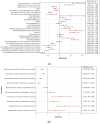School Closures on Bullying Experiences of Treatment-Seeking Children and Youth: The Influence of the COVID-19 Pandemic Within Ontario, Canada
- PMID: 39767512
- PMCID: PMC11675720
- DOI: 10.3390/ijerph21121673
School Closures on Bullying Experiences of Treatment-Seeking Children and Youth: The Influence of the COVID-19 Pandemic Within Ontario, Canada
Abstract
Amongst school-aged children and youth, bullying is a significant problem warranting further investigation. The current study sought to investigate the influence of the COVID-19 pandemic waves and school closures on the bullying experiences of 22,012 children aged 4-18-years-old who were referred and assessed at mental health agencies in Ontario, Canada. Individual, familial, and mental health variables related to bullying experiences were also investigated. Data were collected from January 2017 to February 2022. The pre-pandemic period of study included January to June 2017, September 2018/2019 to June 2019/2020. The pandemic period was divided into categories of remote learning (17 March 2020 to 30 June 2020, 8 January 2021 to 16 February 2021, 12 April 2021 to 30 June 2021) and in-person learning (remaining pandemic dates). The summer holidays pre-pandemic were in July-August 2017, 2018, 2019 and during the pandemic they were in July-August 2020 and 2021. Logistic regressions were conducted to analyze data. Findings related to COVID-19 showed bullying rates to be lower during the pandemic when compared to pre-pandemic levels (bullied others during pandemic in school: OR = 0.44, CI = 0.34-0.57; victim of bullying during pandemic in school: OR = 0.41, CI = 0.33-0.5). Furthermore, bullying rates were lower during the pandemic periods when schools were closed for in-person learning (bullied others during pandemic remote: OR = 0.62, CI = 0.45-0.85; victim of bullying during pandemic remote: OR = 0.24, CI = 0.17-0.34). Children who lived in lower income areas, experienced home life challenges, exhibited mental health difficulties, or had behavioural concerns were more likely to be involved in bullying experiences. Finally, classroom type and school program impacted the child's likelihood of bullying others or being bullied. These findings further our understanding of the impact of school closures on children's mental health and behaviour during the pandemic. Public health and policy implications such as bullying prevention, supervision, and conflict management are discussed.
Keywords: COVID-19; bullying; mental health; school closures; victimization.
Conflict of interest statement
The authors declare no conflicts of interest. The funders had no role in the design of the study; in the collection, analyses, or interpretation of data; in the writing of the manuscript; or in the decision to publish the results.
Figures




Similar articles
-
Association between neighbourhood composition, kindergarten educator-reported distance learning barriers, and return to school concerns during the first wave of the COVID-19 pandemic in Ontario, Canada.Int J Popul Data Sci. 2023 Apr 4;7(4):1761. doi: 10.23889/ijpds.v7i4.1761. eCollection 2022. Int J Popul Data Sci. 2023. PMID: 37181489 Free PMC article.
-
The Association Between School Closures and Child Mental Health During COVID-19.JAMA Netw Open. 2021 Sep 1;4(9):e2124092. doi: 10.1001/jamanetworkopen.2021.24092. JAMA Netw Open. 2021. PMID: 34477850 Free PMC article.
-
Inequitable Changes in School Connectedness During the Ongoing COVID-19 Pandemic in a Cohort of Canadian Adolescents.J Sch Health. 2024 Jun;94(6):509-518. doi: 10.1111/josh.13443. Epub 2024 Feb 19. J Sch Health. 2024. PMID: 38373417
-
Bullying before and during the COVID-19 pandemic.Curr Opin Psychol. 2023 Oct;53:101689. doi: 10.1016/j.copsyc.2023.101689. Epub 2023 Sep 9. Curr Opin Psychol. 2023. PMID: 37690185 Review.
-
Physical activity on the mental health of children and adolescents during COVID-19 pandemic-induced school closures-A systematic review.PLoS One. 2024 Jun 25;19(6):e0299158. doi: 10.1371/journal.pone.0299158. eCollection 2024. PLoS One. 2024. PMID: 38917211 Free PMC article.
References
-
- Centers for Disease Control and Prevention Fast Fact: Preventing Bullying. [(accessed on 5 November 2024)];2014 Available online: https://www.cdc.gov/youth-violence/about/about-bullying.html#:~:text=Qui....
-
- Boak A., Elton-Marshall T., Mann R.E., Henderson J.L., Hamilton H.A. The Mental Health and Well-Being of Ontario Students, 1991–2019: Detailed Findings from the Ontario Student Drug Use and Health Survey (OSDUHS) Centre for Addiction and Mental Health; Toronto, ON, Canada: 2020.
-
- U.S. Department of Education Student Reports of Bullying: Results from the 2017 School Crime Supplement to the National Crime Victimization Survey. [(accessed on 5 November 2024)];2019 Available online: https://nces.ed.gov/pubs2019/2019054.pdf.
-
- UNESCO Prevention of Violence and Bullying in School. 2023. [(accessed on 5 November 2024)]. Available online: https://www.unesco.org/gem-report/en/articles/prevention-violence-and-bu....
MeSH terms
Grants and funding
LinkOut - more resources
Full Text Sources
Medical
Miscellaneous

